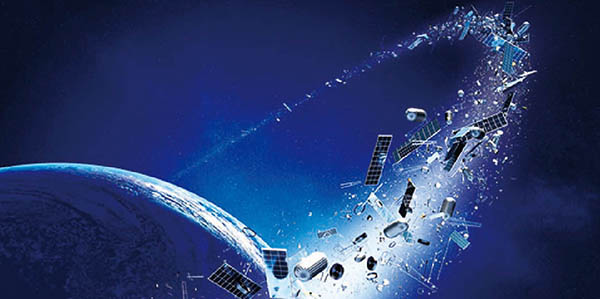Based on the Introductory Remarks made at Digitisation & Networking in the Armed Forces 2020 Webinar, 23 Nov 2020.


An American military commander said in 1958, “He who controls the Moon, controls the Earth.” Earlier, noted strategist and air power votary Giulio Duhet wrote in 1922, ” Victory smiles upon those who anticipate the changes in the character of war, not upon those who wait to adapt themselves after the changes occur.”
When Britain dominated the seas, it ruled the world. The Americans have been dominating the air and space domains, which are now the medium of military operations since the last 50 years. All major powers – USA, Russia, China and even India – are moving aggressively into this domain.
Militarisation of space is a reality. Control and denial of space-based assets is a part of the Chinese PLA doctrine. There has been no war in space but many experts believe that it is more or less imminent.
Space and satellite-based services have changed life on Earth. C4ISR depends largely on space-based assets. Importantly, satellites are used to provide early warning on missile launches, locate nuclear detonations, enable GPS navigation and targeting by airborne EW aircrafts and cruise missiles, high speed satellite communications and situational awareness. Satellite imagery is also used by fighter bombers for physical bombing.
Anti-Satellite Tests
America was in the lead but China has moved in quickly and is investing considerably in space. China sent a man into space in 2003 and carried out an anti-satellite test (ASAT) in 2007. It has a certified satellite global navigation system, BeiDao, with high accuracy. All elements of a 100-ton permanent Chinese space station are in place and it is likely to be fully operational by 2021. Human exploration of the moon is on the cards by 2025 and landing on Mars is planned. China is working on generating energy from space-based orbital solar power plants.
The complexities of ASAT are significant. Proving a point to smash a satellite is one thing, but tackling a military satellite with defensive measures where hundreds of multi-national satellites are orbiting in space is quite another. The interceptor has to pre-determine the point of impact of a satellite orbiting at high speeds as part of a constellation at various altitudes and speeds. That makes it even more complex. The Americans are now developing the concept of escort satellites.
ALSO READ: DIGITAL TRANSFORMATION – Domination of the Air Space
India is making good progress. Chandrayan-2 was lost on the moon’s surface in 2019 but the effort was laudable. India has planned to send Shukrayaan-1 to orbit Venus in 2023.
Space wars are a reality and India is getting abreast of it. Greater space presence requires to have an ability to launch heavy satellites above 5000 kg weight. India already carries out dozens of launches every year and has the ability to launch at short notice, which translates to readiness of launch means for any purpose. Advances in electronics, cyber capabilities and kinetic weapons, coupled with our space launch capabilities, means we can defend our assets and interests in space and be able to use space for military and counter-space purposes.
As far as launch facilities are concerned, ISRO had sent the first GSLV-III rocket in June 2017 to put GSAT-19 communications satellite in orbit. Soon it will have capabilities to launch 5000 kg payloads. It has already launched satellites belonging to over 35 countries. It is planning on a manned mission to the moon by December 2021, for which cosmonauts are already training in Russia.
India currently has 16 military satellites operational. Spectral resolution is going up and the armed forces are using dedicated satellites. We also has access to a number of good foreign satellites. DRDO and ISRO have the capability to destroy satellites and rockets in their booster phase.
Space Exercises
India has already carried out a simulated space warfare exercise with representatives of the armed forces, ISRO, DRDO and think tanks. They looked at the threat from China to our assets and the gaps that need to be filled in and technologies required to be strengthened. India’s Defence Space Agency has been established. This is a stepping stone to a full-fledged Space Command. It was a logical next step after the BMD tests and ASAT test.
India does not subscribe to the 1967 Outer Space Treaty, which bans the stationing of weapons of mass destruction (WMD) in outer space. The treaty has its limitations. Every country has the right to defend its space assets.
The US has a Space Command, which was established in 1985. It was merged in 2002 with the United States Strategic Command but activated again in 2019, with a reemphasized focus on space as a war-fighting domain. In 2020 the US Air Force Space Force was also established. China has created it own PLA Strategic Support Force.
ALSO READ: DIGITAL TRANSFORMATION – Imperatives For Network-centric Operations
India needs to look at global space situational awareness. It will have a vast constellation of satellites in geo-stationary orbit for carrying out multifarious tasks and C4 functions. It will include a cluster of satellites for military ELINT, SAR and electro-optical applications.
Going into the future, India is well on course to develop capabilities to launch heavy satellites, the Indian Regional Navigation Satellite System is operational and should begin to settle down, small satellites (<100 kgs) should start to function in the manner of UAVs with defence applications. Start-ups in the space technology realm are a welcome change. There is a need to review the higher organisation and decision-making set-up and strategy formulation process for war in view of the considerable inputs available from space-based C4ISR data.
India has all the building blocks necessary to integrate ASAT weapon systems, neutralise hostile satellites in low and polar orbit. It needs more early warning satellites to monitor enemy activities and more ground-based systems to neutralise incoming missiles.
India should start work on its space station. There have been dramatic improvements in intelligence inflow but a lot more needs to be done. The time to invest in space capabilities is now.













